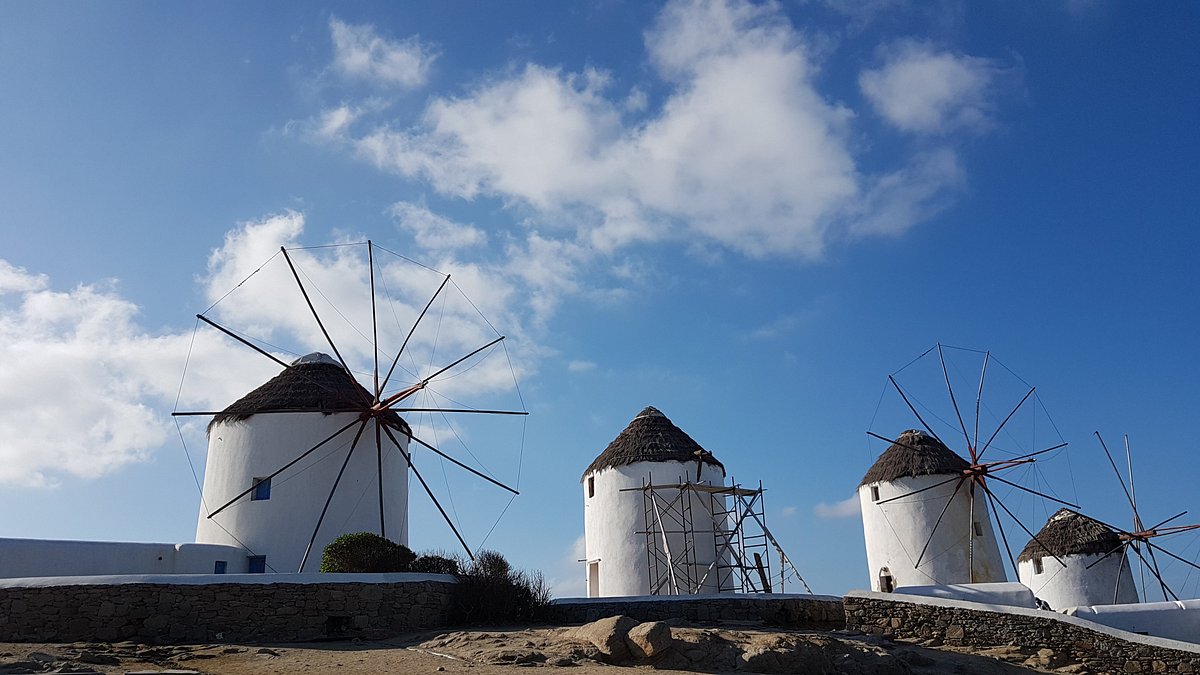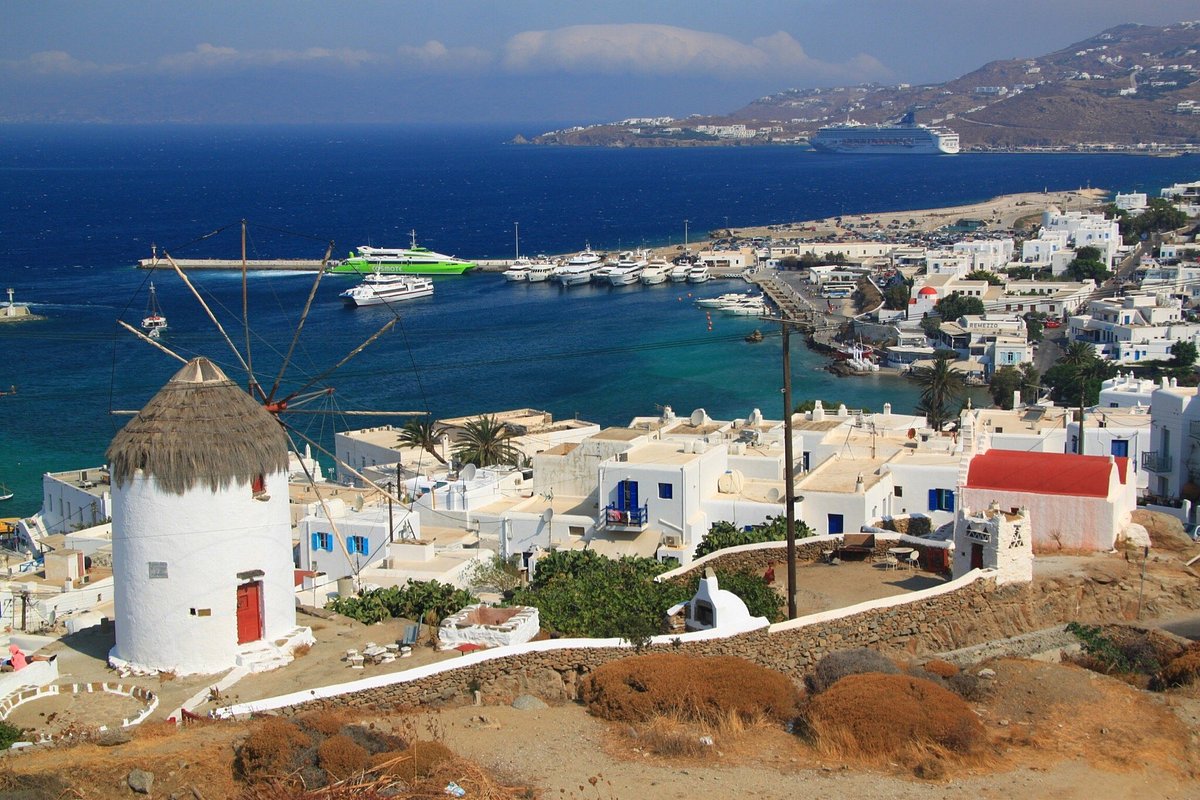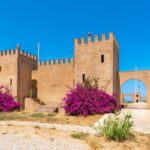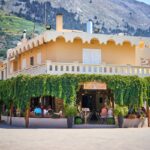Mykonos, a picturesque Greek island in the Aegean Sea, is known for its stunning landscapes, whitewashed buildings, and vibrant nightlife. One of the most iconic features of this Cyclades island is the Mykonos windmills, which have stood gracefully on the landscape for centuries. These historic structures offer a glimpse into the island’s past and its economic development, playing a crucial role in Mykonos’ growth as a trading hub.
The Mykonos windmills, also known as Kato Mili, can be seen from every point of the town of Mykonos, referred to as Chora. At one time, there were 28 windmills operating on the island, making Mykonos a necessary port of call for ships passing through the Cyclades. As a result, the island flourished, famously producing the rusk called ‘paximadi,’ which sailors relied on as a substitute for bread on long sea journeys.
These fascinating and visually striking windmills have become a treasured part of Mykonos’ history and identity, drawing visitors from around the world who come to experience their beauty firsthand. A visit to these windmills offers not only a sense of history and connection to the island’s past but also breathtaking views of the surrounding landscape and the Aegean Sea.
Historical Background of Mykonos Windmills

Origin and Purpose
The windmills of Mykonos date back to the 1500s and were a vital part of the island’s industry. They were primarily used for milling wheat and barley, providing a significant source of income for the inhabitants. The architecture of these windmills is quite similar, featuring a round shape, white colour, pointed roof, and very small windows. The island’s unique position and regular winds made it an ideal location for constructing windmills, enabling efficient use of wind power.
Mykonos had a total of 28 windmills across the island, with 10 of them located in the Kato Mili complex. The oldest windmill on the island is Geronymos Mill, dating back to the 18th century. This mill produced flour until the 1960s and has since been renovated, with most of its original grinding machinery still intact.
Evolution and Decline
With the rise of modern technology and changes in agricultural practices, the use of windmills in Mykonos gradually declined throughout the 20th century. As windmills ceased production in the mid-20th century, they turned into historical landmarks that attracted visitors rather than actively supporting the local economy.
One of the most famous windmills open to the public today is Bonis Mill, which is part of Mykonos’ Agricultural Museum. Here, visitors can get a glimpse of the island’s past and understand how the windmills played a key role in developing the local economy. The picturesque area of Little Venice, located just below the windmills, remains a popular spot to appreciate the view of the windmills and experience a beautiful sunset.
Although the windmills of Mykonos no longer serve their original purpose, they remain an important symbol of the island’s history and a testament to the ingenious use of wind power in earlier times.
Famous Windmills in Mykonos
Kato Mili

Kato Mili, also known as the Mykonos Windmills, is a group of seven windmills located on a hill in Chora, the capital town of Mykonos Island in Greece. Built by the Venetians in the 16th century, these windmills were primarily used for milling wheat and were an important source of income for the local inhabitants. Visible from every point of the island, Kato Mili has become a symbol of Mykonos and a popular tourist attraction.
Boni Windmill

The Boni Windmill, also known as the Agricultural Museum Windmill, is one of the oldest and most well-preserved windmills in Mykonos. Situated at the top of the hill near Chora, this windmill offers a panoramic view of the surrounding landscape. Restored in the 1990s, the Boni Windmill now houses the Agricultural Museum which showcases the traditional Mykonian agricultural practices and artifacts.
Gioras Bakery Windmill
The Gioras Bakery Windmill is another historical windmill in Mykonos Town, known for its traditional thatched structure and unique architecture. Established in the 19th century, the windmill functioned as a bakery and produced the iconic Mykonian rusk called ‘paximadi’, which sailors used as their main substitute for bread on long journeys at sea. Today, the Gioras Bakery Windmill stands as a testament to the island’s industrial heritage and is one of the few remaining windmills in the region.
Visiting Mykonos Windmills

Location and Accessibility
The iconic Mykonos windmills, also known as Kato Milli, can be found on the northern side of the island. They serve as a scenic backdrop to the harbour of Mykonos and are easily accessible by foot from Mykonos Town. As a major tourist attraction, the area surrounding the windmills offers various amenities, including cafes and photo opportunities.
Public transport is also available, as local buses and taxis can bring visitors closer to the windmills. However, walking remains the most popular option, as it allows tourists to take in the picturesque views and immerse themselves in the island’s vibrant atmosphere.
Best Time to Visit
Visiting the Mykonos windmills is an enjoyable experience throughout the year. However, the best time to visit is during the shoulder months of May and September. During this period, the island experiences pleasant weather conditions, fewer tourists, and optimal opportunities for photography.
Visiting the windmills early in the morning or at sunset is highly recommended, as these times offer the most dramatic lighting for capturing stunning photos. Additionally, the area around the windmills is less crowded during these times, making it easier to explore and enjoy the site.
Please note that the strong northern winds, known as “meltemia”, are commonly experienced in Mykonos, particularly during the summer months, so it’s essential to be prepared for windy conditions when planning your visit.

Hailing from the historic city of Thessaloniki, Nikos Tsakiris is a passionate explorer, seasoned writer, and co-founder of Greek Island, the definitive travel blog for the Greek Islands.


